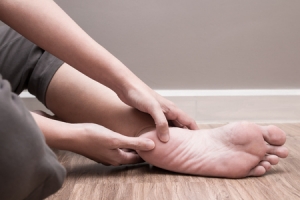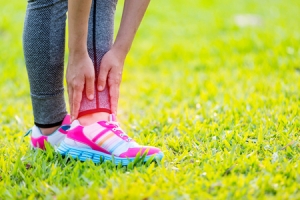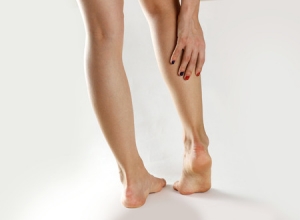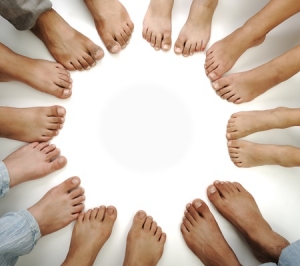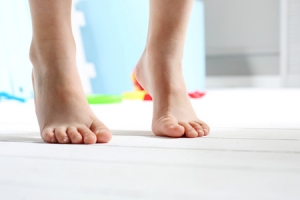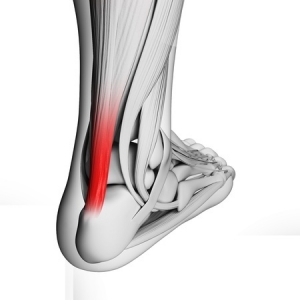Connect With Us
Blogs
Displaying items by tag: Achilles Tendonitis
3 Causes of Back of Heel Pain
At Superior Foot & Ankle Care Center we know that pain at the back of your heel can be quite debilitating. What starts as an annoying ache can quickly turn into excruciating pain that makes walking difficult. For our Los Angeles County patients that may be experiencing these uncomfortable symptoms, here are three possible causes.
Haglund’s Deformity—this is a bony enlargement that forms at the back of your heel. This condition may be the result of an inherited structural issue like a high arch or a tight Achilles tendon. It can also be caused by wearing shoes with stiff backs that rub on the heel—hence this deformity’s other name: pump bump.
Bursitis—small sacs that are filled with fluid—known as bursas—are found throughout the body near joints and bones. They serve as protection from friction and provide a little extra lubrication. When a bursa becomes irritated due to repetitive motion or pressure it can become painfully inflamed. Haglund’s deformity is one cause of bursitis but it may also be the result of repetitive action from exercise or another medical condition such as gout, diabetes or arthritis.
Achilles Tendonitis—this long tendon that runs down the back of your lower leg connects your calf muscle to the heel bone. It can be aggravated or injured from overuse such as someone whose job involves climbing a ladder. Athletes and “weekend warriors” who suddenly increase the intensity of their workout routine may also suffer from Achilles issues.
The only way to find out for sure what’s causing your back of heel pain is to let our podiatrists, Dr. Victoria M. Foley and Dr. Constance Ornelas, examine your foot and conduct the necessary tests to get to the bottom of the problem. You can contact our Long Beach office at (562) 420-9800 office for an appointment. To learn more about foot health and conditions we treat check out our video library.
Helpful Hints for Hikers
Hiking is a great way to stay in shape, spend time with family and friends, and appreciate the beauty of nature. At Superior Foot & Ankle Care Center, we want our patients to keep their feet safe while enjoying this activity. Below are some recommendations before you hit the trail.
Shoe Sense—it all starts with the right hiking shoes or boots. The terrain on trails can be steep, uneven, and unstable. It’s essential that you have the proper foot gear. Get professionally fitted and buy quality-hiking shoes that protect your feet from moisture, provide good support and shock absorption, and have a tread to help prevent slips and slides. If you have chronic foot problem such as weak ankles or heel spurs, see our podiatrists, Dr. Victoria M. Foley or Dr. Constance Ornelas get recommendations for shoe styles and other modifications that will best accommodate your condition.
Proper Planning—if you are planning to hike on a trail you’ve never been on, study a map to determine the length of the trail, whether it’s “in and out” or a circle, the elevation, and how the trail is maintained. Take into consideration your current physical condition and don’t overdo it. Warm-up and stretch before starting a hike to avoid injuries like Achilles tendonitis.
Knapsack Know-How—in addition to granola bars and plenty of water (which will not only keep you hydrated but also reduce the chances of painful swelling in your feet and ankles), you should include a few other items in your backpack. Blisters, though small, can ruin a hike. Pack moleskin and use it as soon as you notice rubbing or a sore spot on your foot. It’s also a good idea to have wraps or elastic bandages in case of an ankle sprain and bandages and antibiotic ointment for minor scrapes or insect bites.
Foot and ankle injuries require immediate medical attention. If you fall, twist an ankle, or injure your feet or ankles in any way while hiking, contact our Long Beach office in Douglas Park, CA by calling (562) 420-9800 as soon as possible. Until you can get in to see us, follow the RICE regimen: Rest, Ice, Compression, and Elevation.
Common Reasons Exercise Programs Fail
At Superior Foot & Ankle Care Center we know the importance of exercise to your feet as well as the rest of your body. That’s why we applaud patients who make a resolution to get in shape in the New Year. Too often, however, by the time February rolls around many exercise plans have already been shelved. Below are some scenarios that can bring fitness plans to a halt and how to work around them.
“Let’s do this! I am going to work out every day to get in shape fast no matter what it takes.”
Not so fast, or you’ll likely end up with an injury. Achilles tendonitis, ankle sprains, and shin splints are just a few of the conditions that can be caused by doing too much too quickly. Not to mention that an overly ambitious start, especially if you’re out of shape, can lead to fatigue and discouragement before you even really get started. The best bet for long-term success is to do an activity or program that allows you to start slowly and gradually increase the level of your workout.
“I started a running program a few years ago and still have my shoes—yay! I won’t have to go out and buy new ones.”
Footwear is one of the most important factors in the success of an exercise program. Getting fitness shoes that are designed for the sport or activity, you’ll be doing is key. However, foot size can change over time. It’s best to get your foot measured professionally and try your shoes on to make sure they are still comfortable.
“I have a bunion, but I think if I put a pad over it I should be able to exercise without a problem.”
Before starting a new exercise program, it’s always best to consult your general practitioner and also your podiatrist. Our foot doctors, Dr. Victoria Foley or Dr. Constance Ornelas, will examine your feet completely. If you have a chronic foot problem, the podiatrist can recommend shoe styles and make suggestions for how to best accommodate your condition. In some cases, a custom orthotic device can increase comfort and performance.
“I’m going to join a gym—there are lots of good deals available now.”
Take the time to consider your likes and lifestyle. A gym is a good option if you like the classes and machines offered and you need to schedule around your work. Consider if you want a more social setting or if you like to work out alone, if you prefer an indoor or outdoor activity and how much time you can devote to your fitness plan. You’re more likely to stick to a plan that suits your interests and your availability.
If you experience any foot or ankle pain or discomfort when exercising, contact our Long Beach office by calling: (562) 420-9800.
4 Ways to Prevent Achilles Tendonitis
At Superior Foot & Ankle Care Center a condition that we frequently see in both experienced athlete’s and “weekend warriors” is Achilles tendonitis. The Achilles tendon, also known as the heel cord, is a band of tissue that runs down the back of your lower leg, connecting your calf muscle to your heel bone. Although it is the strongest tendon in the body, it is also one of the most frequently injured. Inflammation of the Achilles tendon, known as Achilles tendonitis is an overuse injury which is caused by putting too much stress on the tendon too abruptly. If left untreated, the ongoing stress to the tendon prevents the body from repairing the injured tissue and the result is a continued pain. Below are some strategies for avoiding this common podiatric disorder:
- Slow and steady wins the race. And, it helps prevent Achilles tendonitis, too. If you have been inactive for a period of time and wish to resume or start a new exercise program, begin slowly. Gradually increase the length and intensity of your activity.
- Don’t choose pain before gain. Even experienced athletes can experience Achilles distress if they decide to significantly increase the difficulty of their workout. Running hills and stair climbing puts particular strain on the Achilles tendon and should not be suddenly increased.
- Stretch it out. One of the best ways for anyone to head off an Achilles tendon problem is by stretching. Exercises that specifically help to stretch and strengthen your calf muscles will help avoid tendonitis.
- Get some support. Patients with flat feet have a higher risk for Achilles tendonitis because as the arch flattens it increases the strain on the Achilles tendon and calf muscles. Be sure the shoes you wear (both on and off the field) have adequate arch support. Our podiatrists, Dr. Victoria Foley, and Dr. Constance Omelas may suggest a custom orthotic device to wear in your shoes for added support.
If you are experiencing soreness, aching or stiffness anywhere along your Achilles tendon, contact our Long Beach office (562-420-9800) to get it evaluated.
5 Pre-season Tips for Young Athletes
Fall sports practices are in the works and for children and teens that have spent the summer on the couch with a phone or video controller glued to their hands, it can be a shock to their feet to begin a strenuous sports routine. Below are 5 ways we at Superior Foot & Ankle Care Center recommend to ease the transition and protect young feet:
- Start working out. Have your child contact their coach for some suggested pre-season warm-ups. Stress fractures, Achilles tendonitis and other overuse injuries are common when patients overdo physical activity after being a couch potato for a couple of months.
- Find active ways to enjoy family fun. There’s still time for family bike rides, hikes, rollerblading and other physical activities. Not only will this help everyone get in better shape, it’s a great way to enjoy some time together before the hectic fall schedules kick in.
- Read up on a favorite athlete. Who is your child’s sports idol? Encourage them to look up interviews and information about how he or she trains during the offseason. It may give your child the incentive and inspiration necessary to get started.
- Buy new shoes. If your child is starting a sport it’s a good idea to get athletic shoes designed to support their feet for the activity they will be doing. Go to a professional fitness shoe store to get fitted and learn about the best options for your child’s foot. If your child is returning to a sport, check to see that their shoes fit and that there is no evidence of excessive wear. Worn soles, stretched out heel counters and creased uppers are all signs that it’s time to replace the shoes. Wearing shoes that are stretched out or falling apart invites injuries.
- Get a podiatric checkup. This is particularly important if your child has had an ankle sprain, fracture or other sports injury in the past. Our podiatrists, Dr. Victoria Foley and Dr. Constance Omelas will examine your child’s foot to ensure that the injury is completely healed. To make an appointment at our Long Beach office, call: (562) 420-9800.
Avoiding Common Pediatric Foot Problems
At Superior Foot & Ankle Care Center we find that most children’s podiatric issues result either from poor hygiene habits or overuse injuries related to sports activities. One of the difficulties in diagnosing and treating children is that they are not always able to articulate their symptoms or even identify the source of discomfort. Look for these indicators that your child may be experiencing foot or ankle pain:
- Limping or walking or running in an abnormal way.
- Not wanting to participate in sports or other active pursuits that they normally enjoy.
- Complaints of tiredness.
- An increased frequency of trips and falls.
If your child is showing any of these signs inspect their feet completely (but gently—the cause of the pain may be internal). If you notice anything unusual or you don’t see anything but it’s clear that something is wrong with your child’s feet, make an appointment at our Long Beach office so that one of our podiatrists, Dr. Victoria Foley or Dr. Constance Omelas can do a complete podiatric exam.
Practice Safe Sports
You can help prevent injuries and conditions caused by overuse by ensuring that your child has the correct shoes for the sport they are doing and that the shoes fit properly. When children are young it’s likely that they will need a new pair of shoes each season. Have your child’s feet professionally measured and don’t let them wear hand me down sports shoes. Be sure that children warm up and stretch before practices and games and that the conditioning program they are doing allows days of rest between workouts. Heel pain from plantar fasciitis or Sever’s Disease and Achilles tendonitis are some foot conditions that can be caused by too much repetitive activity from a sport or exercise program.
Teach Your Child Healthy Foot Habits
Plantar warts, athlete’s foot, fungal toenails and ingrown nails are also conditions that children commonly experience. These can be avoided if your child follows some simple rules:
- Let mom or dad trim nails appropriately—don’t peel nails or pull them off.
- Wear shower shoes or flip-flops at the town pool and when in gym locker rooms—fungal and bacterial infections are spread by direct contact.
- Don’t share shoes, socks, towels, nail files or any other items that touch someone else’s foot.
If you have questions about your children’s feet, contact us by calling: 562-420-9800.
3 Foot Care Tips for Getting in Shape
If you are like many of our patients at Superior Foot & Ankle Care Center the New Year is a time to renew your commitment to getting physically fit. This is a worthy resolution that will benefit your feet and your entire body. Improved circulation, maintaining a healthy weight, decreased risk of heart disease and high blood pressure and stress relief are among the many benefits of regular exercise. Before you get started, however, we’d like to make the following suggestions to protect your feet and increase the enjoyment of your fitness program.
Get a Checkup—it’s a good idea to meet with our podiatrists, Dr. Victoria Foley and Dr. Constance Omelas and discuss your fitness goals and how you hope to achieve them. Some exercises put more stress on your feet than others. It’s important to have a complete examination of your feet and ankles and to have the foot doctor address any ongoing problems that you may be having. Sometimes special orthotics or padding may be recommended to protect a vulnerable area and make exercise more comfortable. The foot doctor can also make specific recommendations regarding shoes that suit your gait and foot.
Shop for Shoes—if you are going to be trying out a new activity go to a professional sports shoe store to get the correct footwear for your sport. Sports shoes are designed specifically for the types of movement required for specific activities. You should have your foot measured and also let the shoe salesperson know about any foot issues you have. You can avoid blisters by wearing shoes that are the correct size and don’t rub anywhere on your foot. Be sure to pick up some absorbent socks as well. Keeping feet dry is essential to avoid athlete’s foot and other fungal infections from developing.
Don’t Skip the Conditioning—properly warming up and stretching the ligaments, tendons and muscles in your lower legs and feet before and after exercise can help you avoid common injuries such as shin splints, Achilles tendonitis and plantar fasciitis.
If after you begin an exercise routine you notice pain in your toes, feet, ankles, calves or shins, be sure to make an appointment at our Long Beach office by calling: 562-420-9800. Continuing to work out while you are in pain will cause way more harm than good.
Resolve to Walk in the New Year
If getting in shape is one of your New Year’s resolutions, we at Superior Foot & Ankle Center would like to encourage you to consider walking. Walking is a very effective exercise, particularly if you have been inactive in the recent past. Consider these benefits:
- Can be done all year round outdoors (especially with our beautiful Long Beach weather) or indoors on a treadmill
- Walking is an activity that can be enjoyed alone or with others
- Walking lowers blood pressure, blood sugar and cholesterol while also providing a cardiovascular workout, improved circulation, stress relief and weight loss
- No special equipment is needed (except a good pair of walking shoes)
Of course walking can cause problems as well. Blisters, corns and calluses, plantar fasciitis, shin splints, and Achilles tendonitis are all potential conditions that can occur as a result of walking. You can help prevent these problems from developing, however, by following a few simple tips:
- Make an appointment for a podiatric check up before starting your new walking routine. Our board certified foot and ankle surgeons, Dr. Victoria Foley and Dr. Constance Omelas will examine your toes, feet and ankles and determine if there are any pre-existing problems that need to be treated. The foot doctor can also analyze your gait and see if you tend toward over-pronation, which may affect your shoe choice.
- Choose a sensible walking program that starts out slow and gradually increases distance and intensity.
- Always remember to stretch before and after you walk.
- Invest in good walking shoes and get professionally fitted at a sports or fitness store.
A little soreness or stiffness when you start a new fitness routine is normal but if you find you are experiencing ongoing pain or any swelling or other unusual symptoms contact our Long Beach office by calling: 562-420-9800.
“Mom, My Foot Hurts”
At Superior Foot & Ankle Care Center, our board certified foot and ankle surgeons, Dr. Victoria Foley and Dr. Constance Omelas are experts in pediatric footcare. One of the issues in evaluating children’s feet is that the patients are not able to articulate just what the problem or discomfort is. That’s when podiatrists have to become detectives and help track down the condition affecting the child. Here are some of the more common complaints we hear from our young patients and what they might mean:
“It hurts in the back of my foot.” Heel pain in children can be either an overuse issue or due to developmental factors. Medical conditions such as plantar fasciitis or Achilles tendonitis can affect children just as they do adults if an injury has occurred during a sport or if too much repetitive exercise is straining a particular part of the foot. In cases of children ages 8-15, the growth plate at the back of the heel is still forming and this leaves a vulnerable area that can become inflamed and result in calcaneal apophysitis (also known as Sever’s disease, although it is not actually a “disease”).
“It’s too far to walk.” If children complain that their feet hurt after a long walk or that their feet feel “tired,” it can be a sign of flatfeet. This can be tricky to diagnose because children don’t develop arches until between the ages of four and six. The foot doctor has a number of ways to check for flatfeet and the solution may be as simple as an insert for the shoes that will help shape and train the arch to develop properly.
“Ow! Don’t touch my big toe!” Extreme pain in the side of a toe, especially if the toe looks red and swollen is most likely pointing to an ingrown toenail. If toenails are cut to short or children pick them off and they end up with a curved edge, the nail may start to grow down and into the skin. This causes extreme pain and, if the nail actually punctures the skin, can lead to an infection.
“There’s something on the bottom of my foot.” Plantar warts are hard growths that most often form on the balls of the feet or the heel. Caused by a viral infection that enters the skin through tiny cuts, it is very common in children. They may not hurt initially but can grow and spread. Usually a topical medication or freezing will remove the wart.
As children grow and become more responsible for their own personal hygiene parent see less of their feet. It’s important to periodically examine your child’s feet and to listen seriously to foot complaints. If your child is experiencing any discomfort or pain in the toe, foot or ankle, contact our Long Beach office for an appointment today.
What’s Behind Tendonitis?
The day after a particularly intense workout or a long run you may notice pain ranging from mild to extreme in the lower part of the back of your leg. Or, you may be noticing a sluggish feeling in your leg accompanied by stiffness and/or a dull ache that lessens as you stretch the leg and get going with your day. All of these are possible symptoms of Achilles tendonitis—an inflammation of the large tendon that runs between the bottom of your calf muscle and your heel that we see often at Superior Foot & Ankle Center.
Tendonitis is primarily caused by overuse or trauma to the tendon. Scenarios that can result in inflammation and injury to the Achilles tendon include:
- Suddenly increasing the distance or intensity of your run or workout
- Doing too much too soon in a new exercise routine or starting up after a period of inactivity
- Overpronation
- Inappropriate footwear choices
- Not stretching enough before sports or exercise
- A trauma to the tendon caused by a sudden or wrenching movement (like taking off for a sprint)
- Heel bone deformity
- Age related wear and tear
Treatment and Prevention
Mild cases of Achilles tendonitis can be resolved by resting the leg and avoiding activities that put stress on the tendon. If the pain is persistent however, and doesn’t seem to improve with rest, it’s time for an appointment with one of our podiatrists, Dr. Victoria Foley or Dr. Constance Omelas. The foot doctor can evaluate just how severe the tendonitis is and make recommendations for relief. These may include: icing, specific stretching exercises to do before and after exercise and a heel cup or other orthotic device to help prevent overpronation and increase arch support. Wearing properly fitting shoes that are designed for the sport or activity you do and following a sound program that increases in intensity gradually can help prevent inflammation the Achilles tendon.
To learn more about how to prevent or treat Achilles tendonitis, call our Long Beach office at: (562) 420-9800.
